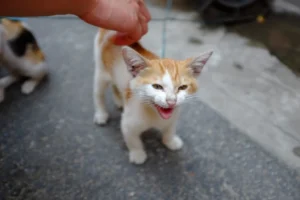Did you know each day we lose many of our feline friends globally? The loss of these companions often leaves cat owners with a profound sense of grief and concern about cat mortality rates.
Cats are an integral part of our lives, known for their agility, grace, and nine lives. However, the reality can be sobering. As we delve into this topic, we hope to shed light on ways to enhance your feline companion’s quality of life and longevity.

How Long Do Most Domestic Cats Live?
When it comes to our domestic feline friends, their life spans can vary quite a bit.
On average, domestic cats that live indoors tend to live between 13 to 17 years. However, with excellent care, regular vet visits, and a stroke of genetic luck, some cats have been known to live into their early twenties or even longer.
It’s essential to note that each cat is unique, and individual health circumstances can significantly affect their longevity.
What Are the Top Causes of Cat Deaths?
In understanding the factors that impact our feline friends’ lives, we can better care for them. Here are the top causes of cat deaths:
- Disease. Diseases, including kidney disease, cancer, and heart disease, are significant causes of death in cats, particularly those in their senior years. Regular vet check-ups can help diagnose and manage these conditions early.
- Accidents. Unfortunate accidents, such as car accidents or falls, are also common, particularly for outdoor cats.
- Ingesting toxins. Cats are curious creatures, and sometimes their curiosity can lead them to ingest toxic substances, such as certain plants, foods, or chemicals.
- Neglect and Abuse. This is a heart-wrenching cause, but sadly, neglect and abuse account for a number of cat deaths. Ensuring proper treatment and advocating for animal rights can help mitigate this.
- Stray and Feral Life. The harsh conditions of living on the streets without regular meals or medical care can lead to numerous health issues in stray and feral cats, drastically reducing their life expectancy.
Remember, knowledge is the first step towards prevention. By being aware of these causes, cat owners can take steps to protect their furry friends and enhance their quality of life.
Are Stray Cats More Vulnerable?
Indeed, stray cats face a multitude of risks and challenges that their indoor counterparts are often shielded from.
Living on the streets, these felines encounter severe weather, limited access to food, threats from other animals and traffic, not to mention a lack of medical attention.
These harsh conditions can make them more susceptible to diseases such as feline immunodeficiency virus (FIV) and feline leukemia virus (FeLV). Moreover, a stray cat’s life expectancy is significantly shorter — typically just 2-5 years, compared to 13-17 years for indoor cats.
There is a silver lining, though: we, as caring individuals, can make a difference in these cats’ lives. Participating in Trap-Neuter-Return (TNR) programs, supporting local cat shelters, and feeding strays in a responsible manner can significantly improve their welfare and longevity.

Ways to Improve Cat Longevity and Welfare
When it comes to improving our cats’ lifespan and wellbeing, here are some concrete steps we can take:
- Balanced Nutrition. Providing your cat with a balanced and appropriate diet is fundamental. Consult with your vet to find a suitable diet based on your cat’s age, health status, and lifestyle.
- Regular Vet Visits. Routine check-ups are crucial in detecting any health problems early. The earlier a problem is detected, the better it can be managed or cured.
- Vaccinations and Preventive Care. Keep your cat up-to-date with vaccinations and preventive treatments for fleas, ticks, and worms.
- Safe Environment. If your cat spends time outdoors, ensure they have a safe area to play in, away from traffic and other potential dangers. Better yet, consider creating an enriched indoor environment to fulfill their need for exercise and stimulation.
- Physical Activity. Encourage your cat to stay active to prevent obesity, a leading cause of health problems in cats. Toys, climbing trees, and interactive games can help.
- Spaying/Neutering. This not only prevents overpopulation but also helps prevent certain health issues, including reproductive cancers.
Remember, every cat is unique, and their needs may change as they age. Regular consultations with your vet will help ensure your cat gets the most appropriate care throughout their life.
Small changes can make a big difference in ensuring our feline friends enjoy a long, healthy life with us.
What’s the Impact of Cat Population Control?
Addressing the issue of cat overpopulation isn’t just about numbers; it’s a matter of animal welfare and environmental responsibility.
Let’s break it down.
Uncontrolled breeding leads to an influx of stray and feral cats struggling to survive in harsh conditions. Moreover, these cats can potentially disrupt local ecosystems, as they are skilled hunters, preying on small mammals and birds.
Conversely, effective cat population control measures, such as Trap-Neuter-Return (TNR) programs, can significantly improve the lives of these cats. By preventing the birth of more stray kittens, we can reduce the number of cats facing hardship on the streets. It’s not just about the numbers; it’s about the quality of life.
Moreover, it’s worth mentioning the impact of cat overpopulation on shelters. With fewer unwanted kittens, shelters can allocate more resources to each cat in their care, improving adoption rates and the overall welfare of the cats.
Essentially, every cat deserves a loving home and a chance at a healthy, comfortable life — and population control plays a key role in making that a reality.
FAQs
What age do most cats die?
The average lifespan of a domestic cat varies, but generally, indoor cats often live between 13 to 17 years. However, it’s not uncommon for well-cared-for indoor cats to reach their early 20s or beyond.
Does neutering or spaying impact a cat’s lifespan?
Spaying or neutering can have a positive impact on a cat’s lifespan. These procedures can prevent numerous health issues, including certain cancers and infections, thereby potentially extending a cat’s life.
What can I do to help stray cats survive?
Helping stray cats can be done by providing food and water, supporting local animal shelters, and participating in Trap-Neuter-Return (TNR) programs. Moreover, consider fostering or adopting if possible.
Does indoor or outdoor living affect a cat’s lifespan?
Yes, the living environment greatly affects a cat’s lifespan. Indoor cats typically live longer than outdoor cats due to fewer threats like traffic, predators, severe weather, and exposure to infectious diseases.
Alex, a passionate animal lover, has experience in training and understanding animal behavior. As a proud pet parent to two dogs and three cats, he founded AnimalReport.net to share insights from animal experts and expand his knowledge of the animal kingdom.




